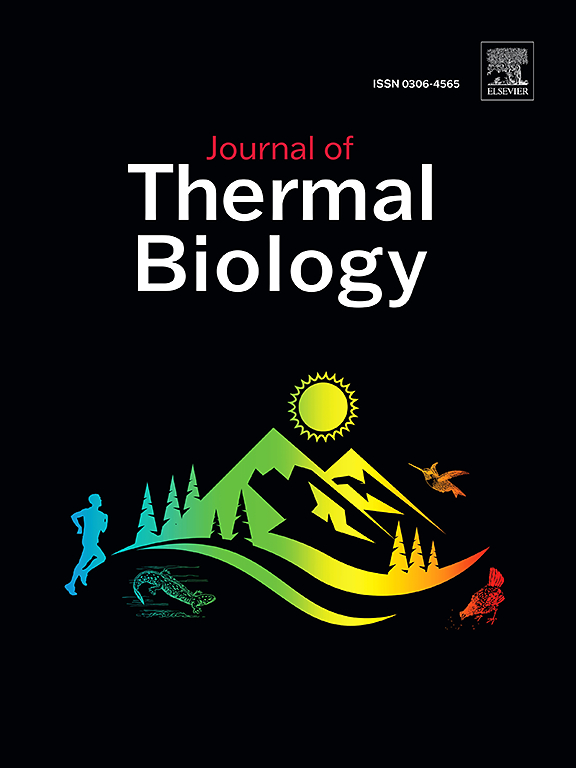冷驯化时间和类型对拟甲虫后续耐寒性的影响
IF 2.9
2区 生物学
Q2 BIOLOGY
引用次数: 0
摘要
研究了冷驯化对冷暴露的黄粉拟甲成虫后续生存和恢复的影响。驯化条件分别为:在5、10、15、25°C和波动温度5 - 10-15°C (8:8:8 h)下的1、2、4和8 d。分别在- 8°C和0°C下的2、3、4、5和6 d诱导急性和慢性冷胁迫。在25℃下恢复5天后记录存活。采用气相色谱-质谱联用法(GC-MS)对在5、10、15和25℃环境下驯化1和4 d的昆虫进行代谢反应研究。在25°C(对照)和5°C(对照)下驯化1天或8天的甲虫在急性冷胁迫后均不能存活。在适应温度波动两天的急性冷胁迫后,甲虫的存活率提高到100%。对慢性冷胁迫后50%种群的致死时间(Lt50)进行了计算,从适应4天波动温度的4.89天到适应5°C 8天的0.018天不等。代谢谱分析表明,各试验组的脯氨酸浓度均最高。冷驯化后,丙氨酸和甘氨酸含量均有所增加。谷氨酸则相反,在5℃驯化4 d后显著降低。丙氨酸的积累和谷氨酸的减少表明丙氨酸来源于谷氨酸和丙酮酸的转氨化。赤藓糖醇、山梨糖醇、阿拉伯糖醇、糖糖醇、木糖醇、葡萄糖和麦芽糖是低温驯化甲虫体内积累的多元醇和糖,特别是在5℃时。甘露糖只在1d驯化的甲虫体内积累。本文章由计算机程序翻译,如有差异,请以英文原文为准。
Effects of duration and type of cold acclimation on the subsequent cold tolerance of a tenebrionid beetle
The effects of cold acclimation on the subsequent survival and recovery of cold-exposed adults of Alphitobius diaperinus (Coleoptera: Tenebrionidae) was examined. Acclimation conditions were: 1, 2, 4 and 8 days at 5, 10, 15, 25 °C and fluctuating temperatures of 5–10-15 °C (8:8:8 h). Acute and chronic cold stresses were induced by keeping beetles at −8 °C for 8 h and 0 °C for 2, 3, 4, 5 and 6 days respectively. Survival was recorded after 5 days of recovery at 25 °C. The insects acclimated to 5, 10, 15 and 25 °C for 1 and 4 days were selected for metabolic response studies which was performed by gas chromatography-mass spectrophotometry (GC-MS). Beetles acclimated at 25 °C (control) and beetles acclimated at 5 °C for 1 or 8 days did not survive after acute cold stress. Survival increased to 100 % after acute cold stress in beetles acclimated to fluctuating temperatures for 2 days. The lethal times for 50 % of the population (Lt50) were calculated for beetles after chronic cold stress and range from 4.89 days in beetles acclimated to fluctuating temperatures for 4 days–0.018 days in beetles acclimated to 5 °C for 8 days. The metabolic profile analysis showed that proline exhibited the highest concentration in all experimental groups. Increases of alanine and glycine in cold acclimated beetles were observed. Glutamic acid had opposite pattern and decreased significantly in acclimated beetles at 5 °C for 4 days. Alanine accumulation and glutamic acid decrease suggest that alanine has derived from transamination of glutamic acid and pyruvate. Erythritol, sorbitol, arabitol, adonitol, xylitol, glucose and maltose were the polyols and sugars that have been accumulated in cold acclimated beetles especially at 5 °C. Mannose has only accumulated in 1d acclimated beetles.
求助全文
通过发布文献求助,成功后即可免费获取论文全文。
去求助
来源期刊

Journal of thermal biology
生物-动物学
CiteScore
5.30
自引率
7.40%
发文量
196
审稿时长
14.5 weeks
期刊介绍:
The Journal of Thermal Biology publishes articles that advance our knowledge on the ways and mechanisms through which temperature affects man and animals. This includes studies of their responses to these effects and on the ecological consequences. Directly relevant to this theme are:
• The mechanisms of thermal limitation, heat and cold injury, and the resistance of organisms to extremes of temperature
• The mechanisms involved in acclimation, acclimatization and evolutionary adaptation to temperature
• Mechanisms underlying the patterns of hibernation, torpor, dormancy, aestivation and diapause
• Effects of temperature on reproduction and development, growth, ageing and life-span
• Studies on modelling heat transfer between organisms and their environment
• The contributions of temperature to effects of climate change on animal species and man
• Studies of conservation biology and physiology related to temperature
• Behavioural and physiological regulation of body temperature including its pathophysiology and fever
• Medical applications of hypo- and hyperthermia
Article types:
• Original articles
• Review articles
 求助内容:
求助内容: 应助结果提醒方式:
应助结果提醒方式:


